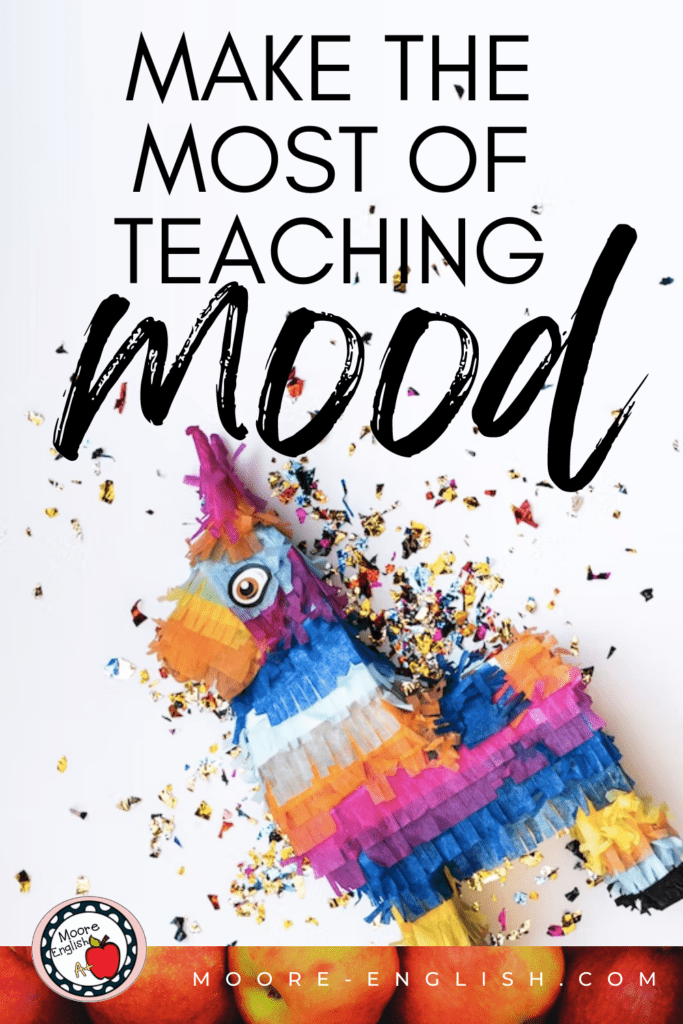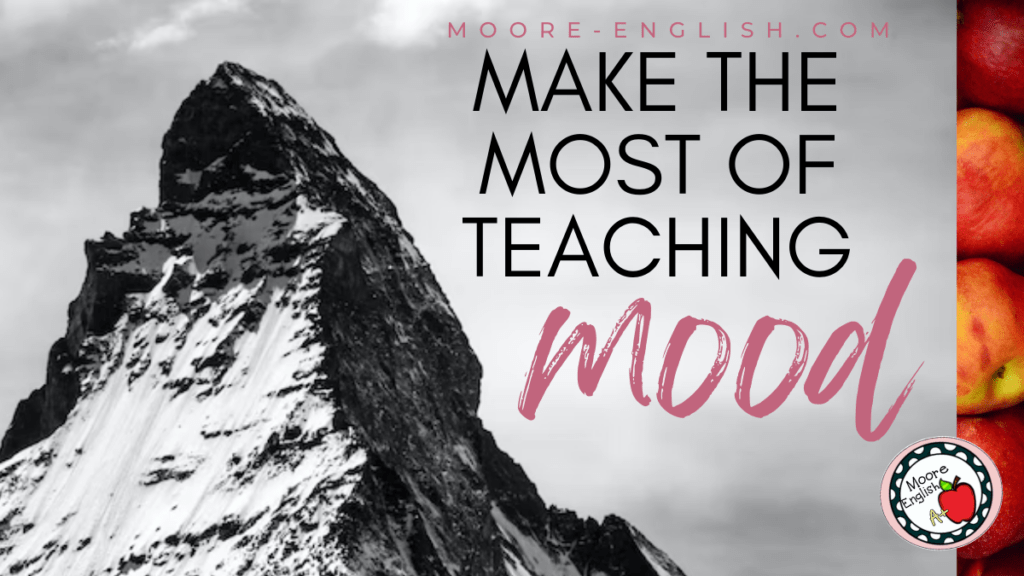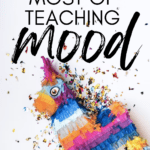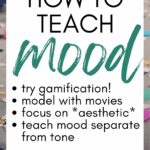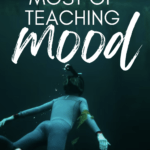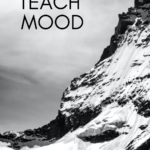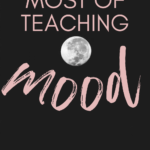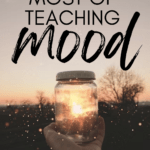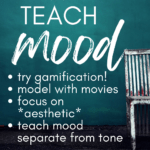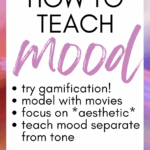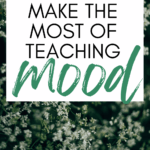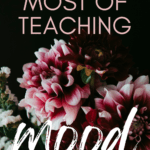Mood is a tricky topic to teach. Students struggle to differentiate mood from tone, and they sometimes see mood as its own literary device when it’s really a product of intersecting choices. After years of trial and error, I’ve made all the mistakes you can make when teaching this (or, really, anything). Now, I’ve come up with a few tried-and-true strategies to share with you!
Moves for Teaching Mood
Before I felt comfortable teaching mood, I made a series of mistakes. Some errors caused students to grow confused. Some choices were unclear. And some texts did not support my instructional strategies, so here are some tricks and tips I’ve learned over the years.
- First, don’t teach mood and tone together. I don’t know how or why these two terms became paired in our collective pedagogical toolbox. But there’s no rule that says these two terms belong together. Since this is a primary hurdle for students, simply separate these terms until students can think of them discreetly.
- Second, students sometimes fall into the “diction trap.” When students first learn the word diction, they want to say “oh, the author used diction.” Well, that’s not quite right. The same thing can happen with mood. No, an author didn’t use mood. The author created mood. To help students make this distinction, it’s important to teach mood as the culmination of a series of author’s choices. Teach mood as the sum of an equation. Mood equals word choice plus imagery plus setting and any other figurative choices an author might make.
- Thid, connect mood to the term “aesthetic.” Students all know what an “aesthetic” is, so this is a great connection they can make when considering mood. The same way students might cultivate images, music, and clothing to create an aesthetic, an author cultivates word choices, imagery, and setting.
- Finally, model analyzing mood with a series of short texts or film clips. For example, the opening scene from Macbeth is an ideal text for modeling analyzing mood. With the witches and the scenery, Shakespeare knocks it out of the park creating a spooky atmosphere. To make this even easier, grab my free activity for analyzing this scene.
Gamify Instruction
Gamification can be a great way to help students practice with various figurative and literary devices. With figurative devices like mood, students need a lot of practice in a short period of time. Here are some perfect games and ideas for helping students practice
- First, this mood game is a student favorite. This is a quick game that can be played in small groups. Students deal out the vocabulary cards. The first player draws a scenario, and other plays choose from theri vocabulary cards to identify the term that best describes the mood of the scenario. The first player choose the most apt term, the winner of the hand keeps the scenario card, and play passes to the right. This is kind of like an academic version of Apples to Apples.
- Similarly, my students love to play BINGO. When students are familiar with a number of literary devices, we often play Literary Devices BINGO. This is a perfect game to engage students and to review terms. Plus, this is a perfect activity to leave with a substitute teacher!
- If students struggle to play whole group BINGO, I sometimes use single-player BINGO. Students use their independent reading books to identify figurative and literary terms in the pursuit of a BINGO. Students still review key terms, but they also stay focused.
- Finally, all three of these games can become part of literary analysis stations. I love stations to promote movement and collaboration in the classroom. Stations are also a great way to mix and match skills and practice and to differentiate. Grab my favorite literary analysis stations today!
Poems for Teaching Mood
Sometimes text selection is the most challenging part of lesson planning. For teachers, it can be difficult to choose a text that covers the term being studied but is also at an appropriate reading level and length. Plus, teachers always want texts that students will find engaging. These poems are all a good length for the classroom, and each one demonstrates how authors create mood and use it to support their purpose.
- First, the song “Calypso” by Suzanne Vega is an ideal text for teaching mood. Vega uses the words of her song along with the musical composition to create an ethereal, dreamy atmosphere. Combining music with the text is a great strategy for helping students with literary analysis.
- Nature is an ideal setting for studying literary devices. For this reason, poems set in nature can be an ideal choice. “The World is Too Much With Us” by William Wordsworth is a gorgeous poem that evokes a strong response. Similarly, “Summer Morn in New Hampshire” by Claude McKay and “Lake Isle of Innisfree” by William Butler Yeats use setting to create mood.
- Additionally, “To a Waterfowl” by William Cullen Bryant takes place in nature. In particular, this text shows how the creation of mood can be representative of an author’s larger literary context. When I teach Romanticism, this is often one of the first poems students analyze. Read it here.
- Finally, my favorite poet Gerard Manley Hopkins is a master when it comes to creating mood. While I love many of his poems, the language in “Spring and Fall: To a Young Child” and “God’s Grandeur” are two texts that showcase his language skills. Read them here.
Longer Works
As students become more adept with literary analysis, it’s time to move on to longer works. In longer texts, students have an opportunity to evaluate how mood works alongside other literary devices.
- First, “The Rime of the Ancient Mariner” by Samuel Taylor Coleridge is the first poem that comes to mind when thinking about mood. Since this is a long poem, it can be read all together or broken down into parts. Especially in the sections that take place in the arctic, the setting and symbolism overlap with the mood to help the mariner learn his lesson. Read it here.
- Similarly, “A White Heron” by Sarah Orne Jewett includes a symbolic bird. The weather in this short story is more mild, but the setting creates a mood that helps readers understand Sylvia’s choice. Read it here.
- Like “A White Heron,” “The Jilting of Granny Weatherall” by Katherine Anne Porter is one of my favorite short stories. Porter’s use of stream of consciousness is a perfect way to help students see how powerful tone and mood can be when they overlap. Read it here.
- Finally, “Winter Dreams” by F. Scott Fitzgerald takes readers through all four seasons. As time passes and the seasons change, the mood develops and evolves. This is also a classic piece where the mood mirrors the character’s journey. Read it here.
How do you make the most of teaching mood?

